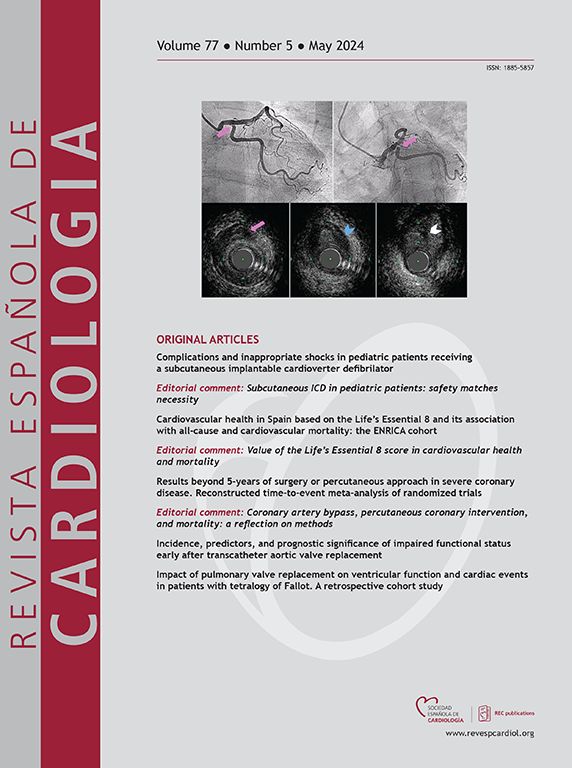Utilidad pronóstica de la angina persistente tras revascularización percutánea en el síndrome coronario crónico con angiografía y RMC de estrés alteradas
IF 5.9
2区 医学
Q2 Medicine
引用次数: 0
Abstract
Introduction and objectives
In patients with established chronic coronary syndrome (CCS), the significance of persistent angina is controversial. We aimed to evaluate the prognostic role of persistent angina in symptomatic CCS patients with abnormal stress cardiovascular magnetic resonance (CMR) and altered angiographic findings undergoing percutaneous revascularization.
Methods
We analyzed 334 CCS patients with Canadian Cardiovascular Society angina class ≥ 2, perfusion deficits on stress CMR and severe lesions in angiography who underwent medical therapy optimization plus CMR-guided percutaneous revascularization. We investigated the association of persistent angina at 6 months postintervention with subsequent cardiac death, myocardial infarction, and hospital admission.
Results
All patients had angina class ≥ 2 (mean: 2.8 ± 0.7), abnormal stress CMR (mean ischemic burden: 5.8 ± 2.7 segments), and severe angiographic lesions. The angina resolution rates were 81% at 6 months, and 81%, 81%, and 77% at 1, 2, and 5 years, respectively. During a median follow-up of 8.9 years, persistent angina was independently associated with higher rates of subsequent cardiac death (13% vs 4%; HR, 3.7; 95%CI, 1.5-9.2; P = .005), myocardial infarction (24% vs 6%; HR, 4.9; 95%CI, 2.4–9.9; P < .001), and hospital admission for heart failure (27% vs 13%; HR, 2.7; 95%CI, 1.5–5.2; P = .001).
Conclusions
In CCS patients with robust diagnostic evidence from symptoms, stress CMR, and angiography, persistent angina after percutaneous revascularization is a strong predictor of subsequent cardiac death, myocardial infarction, and hospital admission for heart failure.
经皮重新肌肉化后持续性心绞痛在慢性冠状动脉综合征中血管造影和应激RMC改变的预后效用
简介与目的在慢性冠状动脉综合征(CCS)患者中,持续性心绞痛的意义存在争议。我们的目的是评估持续性心绞痛对有症状的CCS患者的预后作用,这些患者有异常应激心血管磁共振(CMR)和经皮血管重建术改变的血管造影结果。方法对334例加拿大心血管学会心绞痛≥2级、应激CMR灌注不足、血管造影严重病变的CCS患者进行药物优化治疗加CMR引导下的经皮血运重建术。我们调查了干预后6个月持续性心绞痛与随后的心源性死亡、心肌梗死和住院的关系。结果所有患者心绞痛≥2级(平均:2.8±0.7),CMR异常应激(平均缺血负荷:5.8±2.7节),严重血管造影病变。6个月心绞痛缓解率为81%,1年、2年和5年心绞痛缓解率分别为81%、81%和77%。在中位8.9年的随访期间,持续性心绞痛与随后的心源性死亡率较高独立相关(13% vs 4%;人力资源,3.7;95%置信区间,1.5 - -9.2;P = 0.005),心肌梗死(24% vs 6%;人力资源,4.9;95%置信区间,2.4 - -9.9;P & lt;.001)和因心力衰竭住院(27% vs 13%;人力资源,2.7;95%置信区间,1.5 - -5.2;p = .001)。结论:对于有症状、应激性CMR和血管造影强有力诊断证据的CCS患者,经皮血运重建术后持续心绞痛是随后心源性死亡、心肌梗死和因心力衰竭住院的有力预测因子。
本文章由计算机程序翻译,如有差异,请以英文原文为准。
求助全文
约1分钟内获得全文
求助全文
来源期刊

Revista espanola de cardiologia
医学-心血管系统
CiteScore
4.20
自引率
13.60%
发文量
257
审稿时长
28 days
期刊介绍:
Revista Española de Cardiología, Revista bilingüe científica internacional, dedicada a las enfermedades cardiovasculares, es la publicación oficial de la Sociedad Española de Cardiología.
 求助内容:
求助内容: 应助结果提醒方式:
应助结果提醒方式:


